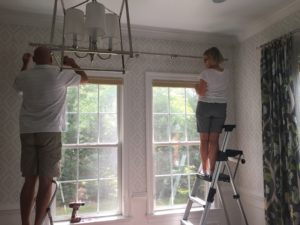After many years in the design business, I know one thing with absolute certainty; window treatments can make or break a room. I have seen it countless times. An otherwise well designed room is brought down by poorly constructed, ill fitting window treatments. I also know that nothing can lift and enhance a space more than a beautifully designed and constructed window treatment. Designing, fabricating and installing custom window treatments is a craft. Actually, I think it qualifies as an art form. And like all art, it requires a gifted master.

Custom Drapery Workroom
There are lots of trades people who can sew and make draperies to basic specifications. There are also workrooms that fabricate window treatments but hire someone else to handle the installation. I prefer to partner with a professional drapery workroom that is a “one stop shop”. For me, a workroom that estimates costs, takes measurements, fabricates and installs is the key for a successful window treatment project. It is best when one set of hands touches the project from start to finish. This minimizes the opportunity for mistakes and misinterpretation of the design.
From design conception to installation, how does the whole process work?
- * First the designer creates the design for the window based on the client’s needs, other design elements and budget. She selects fabrics, trim and hardware.
- * She then takes basic measurements and sends them, along with the fabric, trim and hardware specs, to the workroom for an estimate.
- * After the client accepts the estimate, the designer prepares a work order. It is sent to the drapery workroom with notes, drawings, sample swatches and hardware specifications.
- * A week or so later, final measurements are taken on-site with the designer and the fabricator. This is a very important step. I insist on it, as it insures me that the fabricator understands my design and vision for the space. It also helps us address any structural issues that impact the design and installation. The fabricator should not cut the fabric without this step
- * After several weeks, the fabricator has worked their magic and the treatments are ready to be installed. The designer is typically on-site for all or part of this process. Her job is to make sure everything goes smoothly and, of course, to snap a picture for Instagram!
Custom window treatments have layers. They are complicated and expensive. As a designer, I have learned it is essential to partner with a professional drapery workroom for a window treatment design. Experience and dedication to the details are the key to success!

Taking measurements at a SCL client’s site

Installing hardware for pleated panels at a SCL Design Project

Installing a valance at a SCL Design Project




